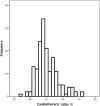Vitamin D deficiency, cardiothoracic ratio, and long-term mortality in hemodialysis patients
- PMID: 32371900
- PMCID: PMC7200666
- DOI: 10.1038/s41598-020-64359-9
Vitamin D deficiency, cardiothoracic ratio, and long-term mortality in hemodialysis patients
Abstract
Hemodialysis patients are a special group of patients with higher mortality rates. Hemodialysis patients with vitamin D deficiency {plasma levels of 25-hydroxyvitamin D [25(OH)D] below 20 ng/mL} are associated with even higher mortality rates. The prognostic importance of vitamin D deficiency in hemodialysis patients with different cardiothoracic ratios (CTRs) is still unclear. This prospective study was performed in a single hemodialysis center, and 186 patients were included. This study analyzed the prognostic importance of vitamin D deficiency in hemodialysis patients with different CTRs. Vitamin D deficiency patients had a significantly higher prevalence of stroke and diabetic mellitus than those without vitamin D deficiency. In addition, the CTR was higher in patients with vitamin D deficiency than in those without vitamin D deficiency. After multivariate logistic regression, we found that CTR was the solitary factor that was independently significantly associated with vitamin D deficiency [odds ratio: 1.07, 95% confidence internal (CI): 1.01-1.13, p = 0.02]. Additionally, vitamin D deficiency was associated with all-cause mortality in patients with higher CTR after adjustment in hierarchical regression models. In conclusion, we reported that vitamin D deficiency was independently significantly associated with a higher CTR. We additionally revealed that vitamin D deficiency was an independent predicator for all-cause mortality in higher CTR hemodialysis patients.
Conflict of interest statement
The authors declare no competing interests.
Figures








Similar articles
-
Vitamin D deficiency--prognostic marker or mortality risk factor in end stage renal disease patients with diabetes mellitus treated with hemodialysis--a prospective multicenter study.PLoS One. 2015 May 12;10(5):e0126586. doi: 10.1371/journal.pone.0126586. eCollection 2015. PLoS One. 2015. PMID: 25965403 Free PMC article.
-
Vitamin D deficiency and associated factors in hemodialysis patients.J Ren Nutr. 2008 Sep;18(5):395-9. doi: 10.1053/j.jrn.2008.04.003. J Ren Nutr. 2008. PMID: 18721733
-
Vitamin D receptor agonist supplementation and suppression of inflammation may have advantage for all-cause mortality in hemodialysis patients.Clin Exp Nephrol. 2012 Oct;16(5):779-85. doi: 10.1007/s10157-012-0626-2. Epub 2012 Mar 29. Clin Exp Nephrol. 2012. PMID: 22457088
-
Prevalence of 25(OH) vitamin D insufficiency and deficiency in chronic kidney disease stage 5 patients on hemodialysis.Hemodial Int. 2007 Jul;11(3):315-21. doi: 10.1111/j.1542-4758.2007.00186.x. Hemodial Int. 2007. PMID: 17576296 Clinical Trial.
-
Vitamin D deficiency, mortality, and hospitalization in hemodialysis patients with or without protein-energy wasting.Nephron Clin Pract. 2011;119(3):c220-6. doi: 10.1159/000328927. Epub 2011 Aug 11. Nephron Clin Pract. 2011. PMID: 21832848
Cited by
-
Radiological Cardiothoracic Ratio in Evidence-Based Medicine.J Clin Med. 2021 May 8;10(9):2016. doi: 10.3390/jcm10092016. J Clin Med. 2021. PMID: 34066783 Free PMC article. Review.
-
Association of serum 25-hydroxy vitamin D with gait speed and handgrip strength in patients on hemodialysis.BMC Nephrol. 2022 Nov 1;23(1):350. doi: 10.1186/s12882-022-02973-7. BMC Nephrol. 2022. PMID: 36319951 Free PMC article.
-
High Prevalence and Risk Factors Associated with Vitamin D Deficiency Among Chinese Hospital Staff: A Cross-Sectional Study.Int J Gen Med. 2024 May 3;17:1833-1843. doi: 10.2147/IJGM.S453473. eCollection 2024. Int J Gen Med. 2024. PMID: 38715746 Free PMC article.
-
The Performance of a Deep Learning-Based Automatic Measurement Model for Measuring the Cardiothoracic Ratio on Chest Radiographs.Bioengineering (Basel). 2023 Sep 12;10(9):1077. doi: 10.3390/bioengineering10091077. Bioengineering (Basel). 2023. PMID: 37760179 Free PMC article.
-
Vitamin D: an important treatment for secondary hyperparathyroidism in chronic kidney disease?Int Urol Nephrol. 2025 Jun;57(6):1853-1863. doi: 10.1007/s11255-024-04334-9. Epub 2024 Dec 30. Int Urol Nephrol. 2025. PMID: 39738859 Free PMC article. Review.
References
Publication types
MeSH terms
LinkOut - more resources
Full Text Sources
Medical

